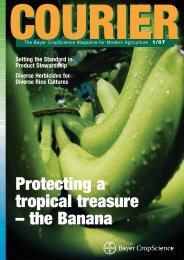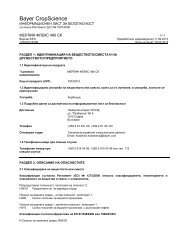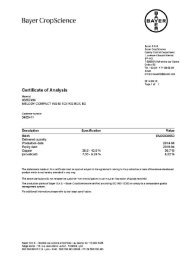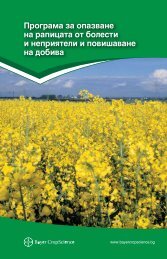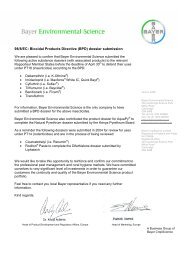For healthy potatoes - Bayer CropScience
For healthy potatoes - Bayer CropScience
For healthy potatoes - Bayer CropScience
You also want an ePaper? Increase the reach of your titles
YUMPU automatically turns print PDFs into web optimized ePapers that Google loves.
specialist<br />
fungicides<br />
Some people search for India and discover<br />
America. Others search for pharmaceuticals<br />
and discover fungicides for crop<br />
protection. Thus, unintended discoveries<br />
can turn out to be ground-breaking. In the<br />
late 1970s, researchers at the <strong>Bayer</strong> Pharmacology<br />
Department in Wuppertal were<br />
actually looking for new pharmaceutical<br />
azoles. Since most of the substances the<br />
research group synthesized showed more<br />
efficacy in plant protection than in human<br />
health care: their efforts culminated in the<br />
creation of a new substance named tebuconazole,<br />
first synthesized in 1981. At that<br />
time, it was not foreseeable that one day,<br />
tebuconazole would become <strong>Bayer</strong>’s bestselling<br />
fungicide.<br />
However, the commencement of <strong>Bayer</strong>’s<br />
azole competence dates back even further<br />
than 1981. The company introduced the<br />
world’s first azole fungicide in 1976:<br />
Bayleton ® . In the following years, triadimefon,<br />
the active ingredient of Bayleton<br />
regularly saved the grain harvest on millions<br />
of hectares of land. In seed treatment,<br />
the novel product Baytan ® – based on triadimenol<br />
– started to replace mercury-containing<br />
mixtures in 1980.<br />
With their azole active ingredients,<br />
Bayleton and Baytan revolutionized fungal<br />
disease control in crops. Most azoles have<br />
systemic properties: they penetrate into the<br />
plant and – depending on the active substance<br />
– are distributed over shorter or<br />
longer distances within its tissues. Thus<br />
both the treated parts, and new shoots and<br />
leaves formed after fungicide application,<br />
are protected for a long time. Furthermore,<br />
azoles have a threefold effect against fungal<br />
pathogens: protection against infection;<br />
cure during the disease incubation period;<br />
and in some cases, eradication of the<br />
disease even after symptoms have become<br />
visible.<br />
2/06 COURIER 3





